
Our teacher Nuria was great. She took us around Madrid to see interesting neighborhoods.

She told us about Puerta Álcala. It marks the gate from which the road leads to the city of Álcala.

After school ended, we made a day trip to Ávila and were amazed by the old city walls. Behind us is one of the nine gates into the old city.

Pete is walking atop the extensive walls. The walls are open for walkers to go half way around, about 1.7 Km. The town with its walls is a UNESCO World Heritage Site.

The Cathedral of Ávila's eastern apse was built into the walls, making it part church and part fortress.
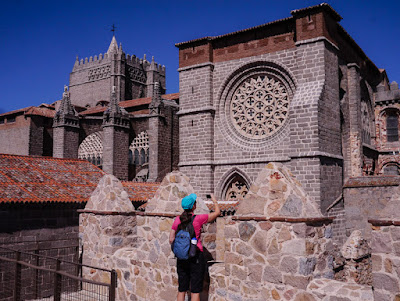
We liked the red and white "blood" limestone that was used to build the oldest part of the church.

The Romans named the town Abila and lived here from the 5th century.
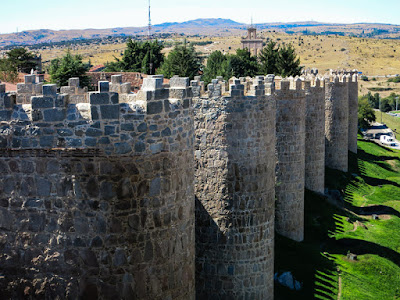
When the Spanish built the walls between the 11th-14th centuries, they dismantled the Roman necropolis to re-use the burial stones: the owl-shaped stone in the upper right was a Roman stele, and the two stones with basins in them were Roman cists used for burying ashes.

This church inside the walls is still in use. Ávila has the most churches per capita in Spain.

Storks have built nests on this old facade, which is quite common here.

This facade of a church just outside the walls is all that remains.

Back in Madrid we moved to a larger Airbnb apartment in anticipation of Kristina’s folks coming to travel with us. Here’s the view from the new apartment looking down on the pedestrian-only street near Puerta del Sol.

Kristina is with her mom Patty and stepdad Bill in Puerta del Sol. The bear eating the strawberry tree is the symbol of Madrid.

This is kilometer marker 0 for Spain. It's located in Puerto del Sol, so we were right in the center of Spain.

We walked around Cibeles Plaza.

Cibeles is the Greek goddess of fertility.

These pretty displays of potted plants were in front of the Madrid City Hall.

We stopped for a late lunch, as is the custom in Spain.

We especially liked the tuna with tomato confit.

After lunch we went to El Retiro park and walked around. This helped Patty and Bill stay awake so they could get used to the time difference here.

This statue celebrates the arts and has King Alfonso II on top.

The next day Patty and Bill were feeling pretty good, so we spent time in the Thyssen-Bornemisza museum, which is known for its portraiture collection.

They also have contemporary art, like this René Magritte painting entitled La Clef des Champs.

And we walked around some more, enjoying the beautiful old buildings in Madrid.

Here’s a cute shot of Patty and Bill during lunch.

That evening we went for tapas, small plates, at the Mercado de San Miguel. The glass building is filled with delicious choices of food and drink and is beautifully lit.

Patty is enjoying the Spanish wine and Pete found a bar that serves Vermouth on tap.

We’ve settled into a daily routine of going for coffee around noon. This day we made a special trip to Chocolateria San Gines.

San Gines is the oldest Chocolateria in Madrid, and they serve the traditional treat of chocolate con churros or porras. We opted for the thinner churros that are in the front.

The hot chocolate is really thick because it’s not for drinking, it’s for dipping the churros.

Pete’s face shows what we all were thinking, “Me gusta chocolate con churros. ¡Que tan rico!”

After the chocolate we were fueled for another day of sightseeing, and we headed to Palacio Real, the royal palace of Madrid.
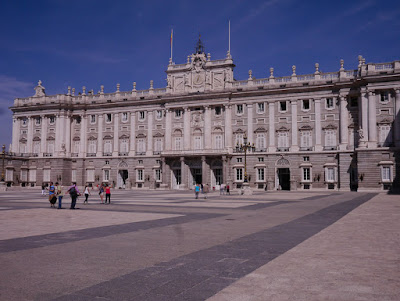
Kristina, Patty and Bill are in the plaza near Palacio Real.

We went to a nearby park and enjoyed strolling the grounds.

There were nice views of Palacio Real and the nearby church.

We went for lunch at Calle 30, which is our favorite restaurant in Madrid. We enjoyed traditional dishes for our first courses: we had cold tomato soup, Bill had fried eggplant with honey, and Patty had rice colored with squid ink and served with small pieces of squid.

After lunch we strolled though Plaza Espana and took photos of Kristina and Patty with Don Quixote and Sancho Panza. It’s the 400th anniversary of publishing Don Quixote part two, so there are many reminders of Cervantes in Madrid.

We went to Toledo on the train. The train station was built in 1920 in the Neo-Mudejar style reminiscent of the Moors.

The short walk from the train station along the river into Toledo offers pretty views of the city walls.

Pete and Patty are on one of the five bridges into the old city.

It’s always fun to try to get all four of us into a selfie!

We walked into Toledo through this arch.

The curved streets and old buildings are charming.

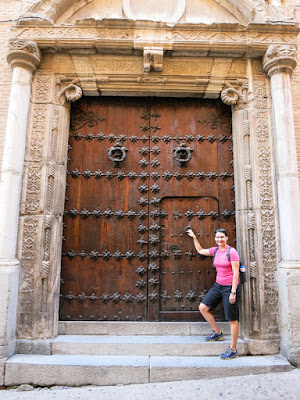
This is part of the exterior of the Cathedral of Toledo. It is immense and built in the French Gothic style.

The main altar was created early in the 16th century and is over-the-top Gothic with gilding and filigree.

Behind the altar is this very Baroque Transparente, so named for the huge skylight that lets in natural light.

El Greco was from Toledo and the sacristy has a dozen paintings by him. This is The Disrobing of Christ. At the bottom of the photo you can see lots of people also visiting the cathedral, but luckily Toledo wasn't mobbed with tourists as it can be in summer.

Another side chapel has the traditional Gothic columns and ceiling.

After the enormous cathedral we took a rest in a nearby park.
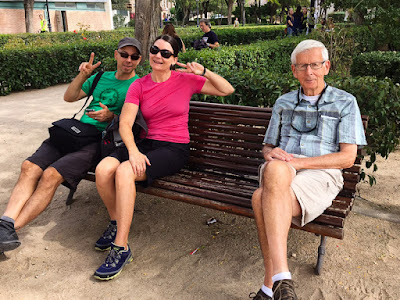
Then we had no trouble eating a three course lunch: It must be all the hills in Toledo that helped us work up our appetites.

We visited the San Juan de los Reyes Monastery.


The courtyard has orange trees and other nice plants. The eagle head is a drainage pipe from the roof.

Patty mailed some postcards from Toledo. Good thing that the lion mail slot didn't try to bite her!

We think these Spanish women were having a bachelorette party, and the woman in red is the bride-to-be.

There is even a street named Toledo de Ohio here, because they are sister cities.

Pete missed an opportunity to pose like Cervantes, who has his chest puffed out. We learned there are no surviving portraits or photos of Cervantes when he was alive, so who knows if this is what he looked like.

As we drove from Madrid to Valencia we saw wind turbines, but no windmills to joust with. Spain is the 4th largest producer of wind energy in the world, creating more than 21% of all its energy with wind power.

On our way to Valencia we stopped for coffee, and Pete found a horsey ride. Perhaps he felt like being silly because it was his 49th birthday!

To celebrate Pete’s birthday, Patty treated us to a special lunch at El Bolon Verde.

First we ate seven different types of fish as appetizers. This is tuna and white anchovies over tomatoes.

We loved the squid and shrimp served over large white beans with a tangy sauce.

The main course was paella. What a huge pan!

We stayed in the new part of Valencia, across from the City of Arts and Sciences, which is a huge architectural complex and park designed by Santiago Calatrava. Here’s our view from the balcony. The largest building is El Palau de les Arts Reina Sofia, an opera house.

Bill and Patty enjoyed the views from the balcony.

We liked walking around the park and checking out the sculpture.


Pete is in front of the enormous science museum building that looks like the skeleton of a whale. The museum didn't have good reviews, so we didn’t go inside.

This close up of the science building shows some details.

In the foreground the science museum is framing the Agora convention center, which is slightly masked by the Calatrava suspension bridge.

The bridge is named El Pont de l'Assut de l'Or and is the highest point Valencia. It's so large that it's difficult to photograph.

The architect and engineer Calatrava is from Valencia. His bridge is nicknamed “the ham holder” by locals.

The City of Arts and Sciences is an impressive complex. Behind Bill and Kristina is l’Umbrecle that houses plants native to Valencia.

The first building completed in the complex was the Hemesferic, an IMAX cinema and planetarium, designed to resemble a human eye.

In this photo the Hemesferic and the opera house are shown. It took over ten years to build the whole complex.

In contrast we went to the old quarter of Valencia. This is the original coat of arms for the city, with a bat atop the crown.

This is the City Hall.

Kristina is on the balcony of the City Hall.

Looking down from the balcony you can see that the sidewalks are marble.

We visited La Lonja, the silk exchange building, which is a UNESCO World Heritage Site.

The courtyard has orange trees that frame the building nicely.

Starting in the 15th century, silk merchants would meet to make deals in the Hall of Contracts.

We went up the stairs to where the silk tribunal met.

We liked the beautiful copper door.

The ceiling is spectacular, and the room is furnished with the original table and chairs.

We loved walking around Valencia and looking at the old buildings.

Of course there is some modern graffiti too.

We noticed graffiti with political commentary on police brutality.

We saw some yarn bombs here, with yarn being woven into wire on the front of buildings. Here the house was decorated with yarn roses.

The Mercado Central has a dazzling array of foods housed in an Art Nouveau iron, glass and tile building.

The jamon displays were particularly impressive.

We had read about horchata in our guide book and wanted to try it. Kristina thinks it tastes pretty good.

Horchata is a summer beverage made of ground almonds called chufa mixed with sugar and water. We liked these tiles showing a traditional Valencian woman serving horchata.

We went to the train station and saw the exterior decorated with oranges and orange blossoms ceramic tiles.

The interior has gorgeous mosaics in the Austrian Art Nouveau style.

Buen Viaje means have a good trip, and we certainly are!

We are heading next to Granada and Sevilla.